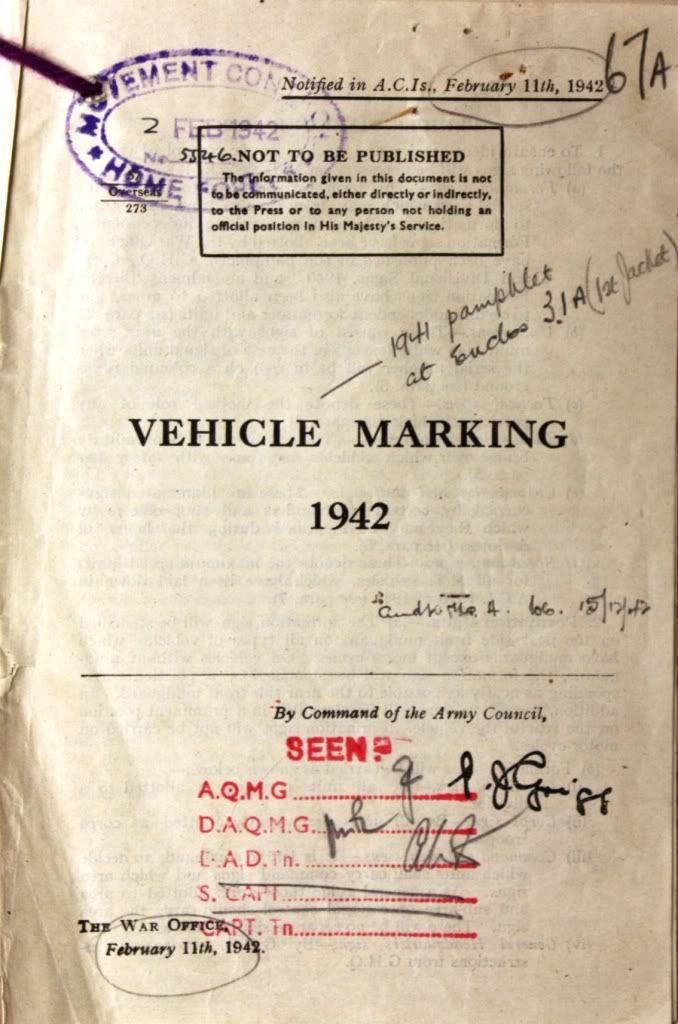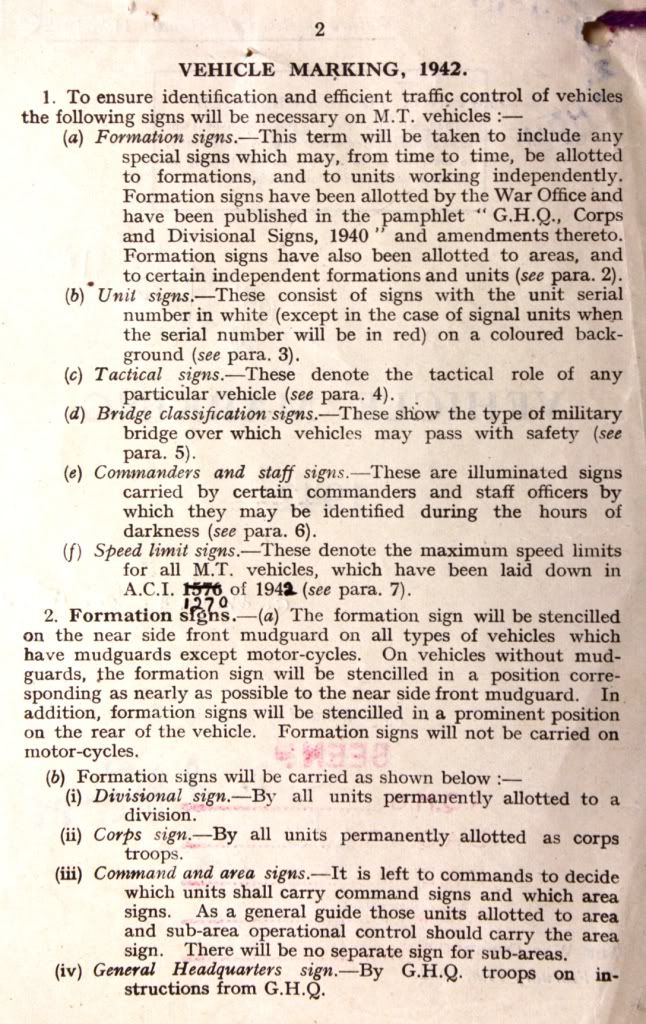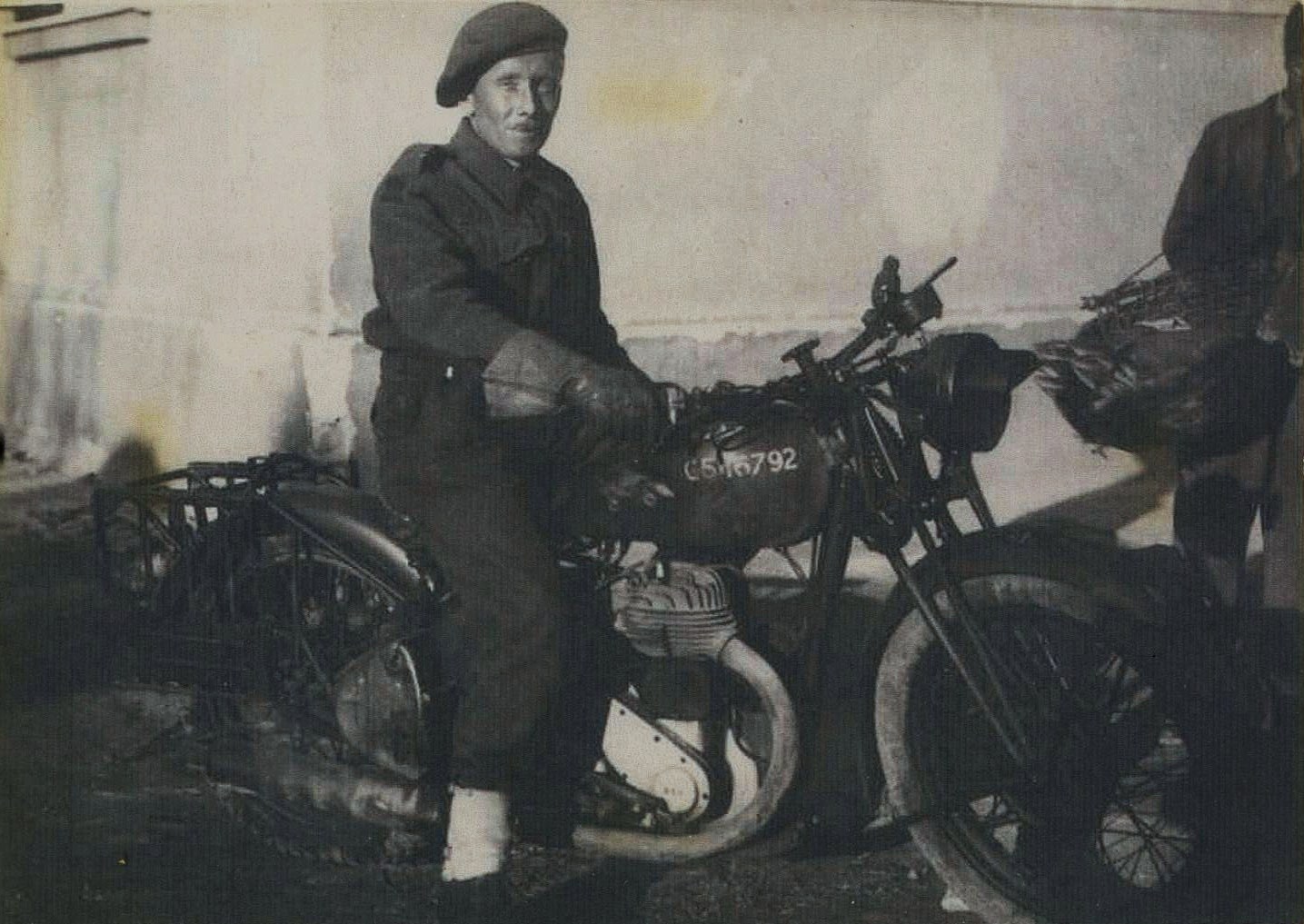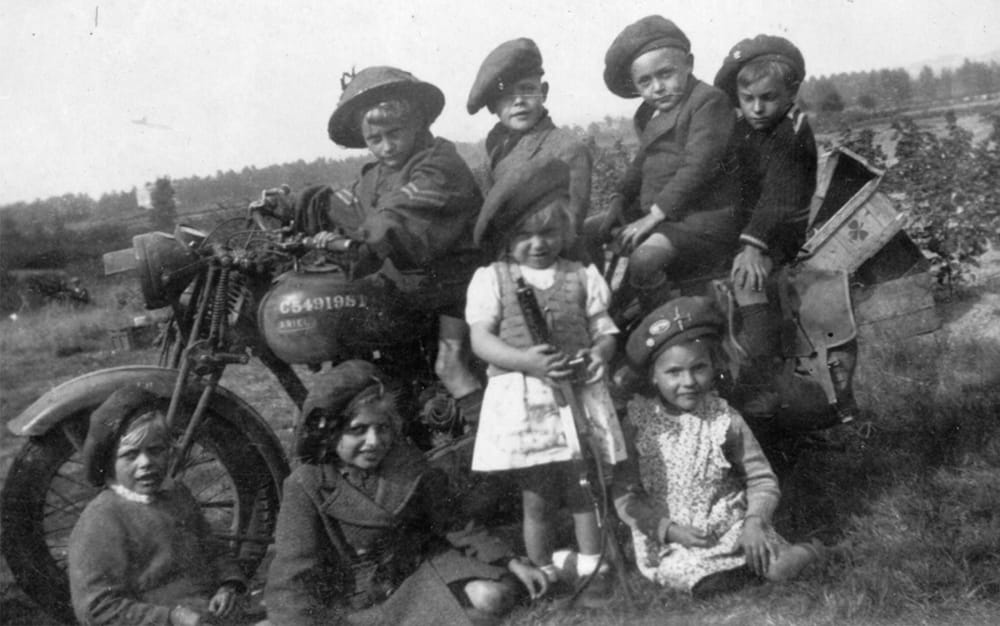It has generally been thought that the earliest reference to the discontinuing of Formation Signs on WD motorcycles was the Army Council Instruction dated October 1943 referred to in Hodges & Taylor's 'British Military Markings'.
However, recent research at the National Archive has now turned up the Army Council Instruction 'Vehicle Marking 1942' dated 11th February 1942 stating that they were not to be displayed on motorcycles. This effectively means that formation signs were only applied to fuel tanks from probably early-1940 to late 1941.


Nice one Rik
Luckily rules always were made to be broken, and the fact that some airborne motorcycles appear in photographs with formation signs must prove it? Rob.
email (option): robmiller11@yahoo.co.uk
Rob, I'll contact you by mail as there is lots more information that will only interest the real numbers nuts and probably too much to post here.
Airborne were of course a bit of a law unto themselves, as with the Guards regiments, they wouldn't have been beyond bulling their vehicles for propaganda opportunities. The Canadians too seem to have had their own rules.
I suspect that as with battledress insignia, post D-Day, as the situation improved, the application of rules relaxed.
Brilliant post Rik. I'm one of those nutters you speak of. Can I also get this information?
Cheers,
Robb
email (option): britool51@hotmail.com
Mere details..
 ..my 42 M20 will emerge from its winter rebuild with Div. and Unit Markings.
..my 42 M20 will emerge from its winter rebuild with Div. and Unit Markings.
Far be it for me to put the signwriter out of his job...and they do look good with the Div. Markings on...Ian
email (option): ian@wright52.plus.com
Robb, I'll mail you.
I quite agree Ian and I don't understand the logic of not applying the formation sign to motorcycles. It must have made for a Traffic Control nightmare, especially as the motorcycles would generally have been the first element of a convoy to reach the TC point.
It would be nice one day to find a record of the thinking behind the decision. Probably just a Cavalry Lieutenant Colonel at the War Office who missed his horse and hated motorcycles !
Arm of Service markings remain correct of course (but were useless without the formation sign).
I would be interested in getting a copy/scan?
Hint to Rik: we wil be at Zutendaal end of June again.
Me too.
Henk
email (option): ahum@quicknet.nl
Hi Rik . I am interested in finding out anything I can regarding how my 1944 bike would have originally looked . I have the 'C' vehicle number which would have been painted on the tank , thanks to Henk , but behond this I am still in the dark . Im generally interested in finding out about original markings/formation signs, even if they dont shed any light on the original spec of my bike , I'm just thirsty for knowledge on the subject, so if you're willing to pass on any information you may have I'd greatly appreciate it . Regards, Leif Evans .
email (option): leifevans75@yahoo.co.uk
Leif, the system of markings is logical and not especially complicated but it is not always fully documented and local adaptions mean that we're still finding new exceptions to the rule.
When in service, a 1944 built army motorcycle would have had basically just an 'Arm of Service' marking on one or both sides of the fuel tank. This is the coloured square with a number on it indicating the type of unit to which it belonged.
If you're intending to apply one to your bike then you'll need to choose a time, place and type of unit and then it's fairly straightforward to look up.
Ten years further, and I'm still obsessing over vehicle signs...
A copy has now come to light of the Army Council Instruction 'Vehicle Markings 1941' dated 8th January 1941 and it would seem to include the first appearance of the instruction that formation signs were not to be displayed on motorcycles.


This instruction was repeated for 1942 and 1943 (The 1943 ACI was actually dated October '43 so as near as damn-it almost a 1944 publication.
It's hard to avoid the conclusion that after 1940, any motorcycle displaying a formation sign was in contravention of Army Council Instructions.
You're such a killjoy Rik...:laughing: ...Ian
email (option): ian@wright52.plus.com
Oh no..... the rivet counters will be scrubbing markings off their tanks now :grinning:
Well done for finding that out Rik :+1:
email (option): horror@blueyonder.co.uk
I find it 'important' to know, Ian but what people do with the information is entirely up to them.
I'm still hoping to find a document indicating precisely why this apparently illogical change was made. It's also odd as there is no mention of existing markings being removed but neither is there the rider that they should not be which is what one usually sees on any instruction that would have cost paint and materials such as the old 'PASS' plate system.
Fantastic, got my bike in Shiny 9th so could you send me a copy also .
email (option): chriscool@sky.com
Very interesting and a great find... My WM20 is a 43 so I guess Ill just stick to the plan of just the C number
email (option): wadeschields@mindspring.com
In practice, formation signs were widely used throughout WW2 and continue to be to the present day, with or without "rule" books!
I have extensive photo files sorted by WD Serial ('census') numbers and in fact it's very difficult to find images of motorcycles which went into service with the British Army later than 1940 displaying Divisional or Corps type Formation signs....all other vehicles did, of course.
Post-war use or by the allies using British equipment such as Canada or Poland etc. isn't the subject of this instruction.
It's easy to say 'in practice formmation signs were widely used' but it is contrary to Army Council Instructions that 'Arm of Service' markings be displayed on both front sides of motorcycle fuel tanks and quite frankly the photographic record doesn't support their widespread use from 1941 onwards.
Amen to that Rik!!!
Lex
email (option): welbike@welb**e.net
Hi Rik,this photo taken in 1944 has 30 corps sign on the front mud guard,the five pages are from a large folder from a soldier who went to France in 1939,there are odd bits about M/Cs in it as shown on the first five pages,but most of the vehicle info covers four wheels,will go through it to find any more M/C info if you are interested,in the first five pages theres info on formation signs.






I'm always interested in the content of BEF-era documentation, Steve. Fascinating stuff.
Is that photo 1944 or the spring of 1945 ? The 'open-flap' headlamp mask makes me suspect that air-supremacy was beyond doubt. It's interesting that the sign is on the mudguard. Although unauthorised, they haven't applied it in an incorrect position, where the armo of service sign was specified.
I see he has tyre pressures and a fairly invisible allied star as well....I doubt a passing Typhoon pilot would see that...:laughing:....Ian
email (option): ian@wright52.plus.com
Tiffie pilots identified their targets. P47s were more of a worry. :face_with_rolling_eyes:
'2' even though it lacks the Corps bar must mean 73rd Anti-tank Regt. in the context of 3 Corps...It does seem as if he liked to have as many markings as possible.
I wonder if it's an "8" from the Casualty Clearance Station ? Can you read his shoulder title ?
No, but he is wearing a RAOC cap badge in the photo in hospital blues. The 69 is quite faint I wonder if the bike was exchanged by an Infantry Battalion and it hasn't been repainted yet?
Rob
email (option): robmiller11(a)yahoo.co.uk
These Germans take no notice of the rules whatsoever...3rd. Panzer Div., probably early in the Russian campaign....:laughing: ...Ian

email (option): ian@wright52.plus.com
Originally I thought this was Italy 1944, but I'm now thinking it was more like Greece during the Civil War of 1945.
There is something on the front mudguard, but I can't make it out.

Mark
email (option): pes.sales@btconnect.com






